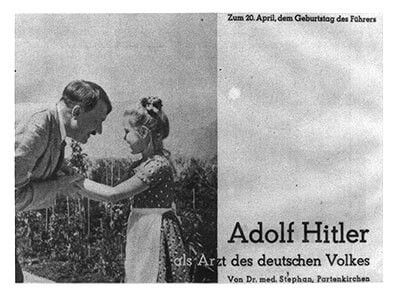|
"Infectious Germs." Under the microscope are symbols for Jews, communists, and homosexuals (triangles), alongside the British pound and the American dollar. The popem at the bottom reads: "With his poison, the Jew destroys / The sluggish blood of weaker peoples; / So that a diagnosis arises, / Of swift degeneration. / With us, however, the case is different: / The blood is pure; we are healthy!" / From Der Stürmer, April 15, 1943, p. 1. |
| The Nazis constructed reality based on a shared fantasy. This fantasy was contained within and articulated by the metaphors they used. Metaphors within ideological rhetoric convey the fantasy that an ideology seeks to express. |

"Adolf Hitler, Doctor of the German People." From Die Volksgesundheitwacht, Ostermond 1935, p. 3. |
|
Metaphors within political rhetoric define and reveal the “cognitive structure” of an ideology. However, they also allow us to decipher the meaning of the ideology.
Metaphors do not come out of nowhere, nor are they abstract, intellectual concepts. They originate from a deeper place within the psyche. Metaphors convey the fantasy that is contained within the ideology.
The term “body politic”—and the idea of Jews as a “disease” within this body—do not refer to real dimensions of the external world. These terms contain and express symbolic meaning. Metaphors within political rhetoric define the fantasy that the ideology seeks to express.
Hitler, Himmler, Goebbels, and many others were caught up—one may say possessed—by this fantasy of the Jew as the source of a disease within the German body politic. When a fantasy is held or embraced in common by large number of people within a society, we call this a shared fantasy.
The Nazi death camps are a profound example of the “social construction of reality.” However, the reality that the Nazis created or constructed was not random.
The Nazis constructed reality based on a shared fantasy. This fantasy was contained within and articulated by the metaphors they used. Metaphors within ideological rhetoric convey the fantasy that an ideology seeks to express.
Hitler did not “use” metaphors to manipulate the German people. His ideology expressed who he was. The metaphors in his writings and speeches contain his felt experience. His ideas do not depict reality. Rather, his ideas and ideology convey fantasies that possessed him—that he wished to share with others.
There is nothing hidden about Hitler. His Secret Book reveals nothing that one doesn’t learn from his writings and speeches. With Hitler, what he said in public was who he was. Hitler was beloved by the German people precisely because of his sincerity. His utterances—expressing his feelings and experience of the world—came flooding out of his mind and body.
Anthropologists are intent upon applying the principle of cultural relativity to “primitive” societies. One enters into the world of the “other”—aspiring to see things from the perspective of a foreign culture. One seeks to imagine what it might be like to think and feel from within a society other than one’s own.
It is best to approach Nazi Germany—1933-1945—as a foreign culture. So many explanatory schemes begin with the assumption that they were “just like us”—therefore how is it possible that they behaved as they did? To understand Hitler and the Nazis, one must enter their strange world.
The photos to the right capture and convey the essence of Nazi culture. The first photo shows a microscope—with Jews, communists and homosexuals depicted as “infectious germs.” Of course, Jews weren’t “really” germs. When Hitler, Himmler and Goebbels spoke about Jews, they were not expressing “rational” ideas. They were conveying their felt experience: something deep within their minds and bodies.
This photo—and similar metaphors that appear everywhere in Nazi rhetoric—contain and express a symbolic meaning. The Jew is imagined as the source of Germany’s illness—cause of the suffering of the German people. Metaphors within Nazi rhetoric express a certain fantasy about Jews. The Jew is conceived as the source of German misfortune; equivalent to a pathogenic organism causing Germany to become ill.
The second photo to the right—with the caption, “Adolf Hitler, Doctor of the German people”—expresses the central fantasy that generated the Final Solution. Hitler was conceived as a leader who was capable of relieving the suffering of the German people—rescuing them from death. He was the doctor who would cure their disease. |